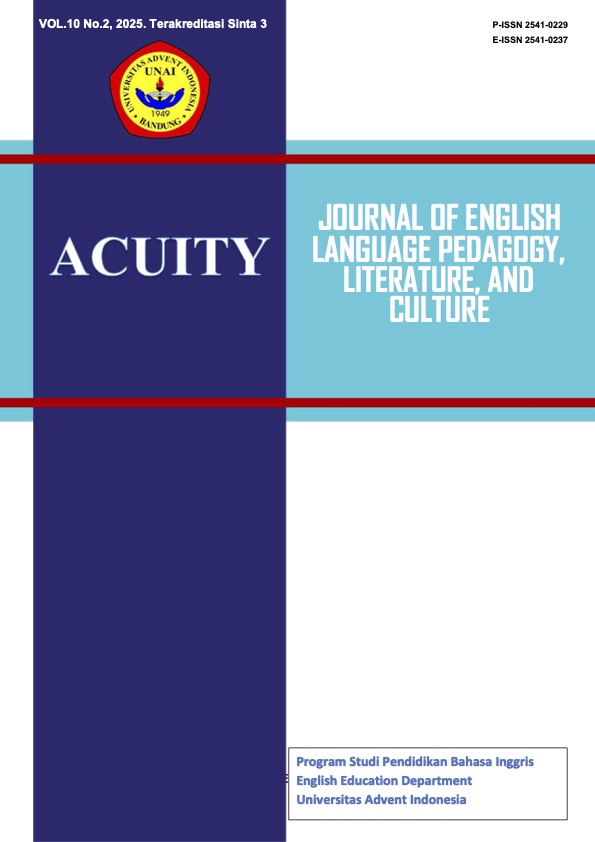CLIL Projects for Critical Thinking and Digital Citizenship in Moroccan Classrooms
Keywords:
CLIL, critical thinking, digital citizenship, Moroccan cultureAbstract
This study examines the effect of Content and Language Integrated Learning (CLIL) project-based learning, incorporating Moroccan culture and digital citizenship, on the critical thinking, cultural consciousness, and local identity of first-year middle school students in Morocco. The study employs a quasi-experimental design, involving an experimental group (n = 28) instructed using the CLIL strategy and a control group (n = 28) receiving traditional instruction. To evaluate progress in their critical thinking abilities and knowledge of Moroccan cultural traits, both groups were administered pre- and post-tests. The data was analysed using paired t-tests, which demonstrated a substantial increase in the post-test scores of the experimental group compared to the control group. These results indicate that integrating digital citizenship and local culture into CLIL can improve the critical thinking skills and cultural awareness of students. The significance of culturally applicable content and pedagogical approaches in the development of intercultural competence and awareness is underscored by the study. The results are limited by the small sample size and brief duration, indicating the necessity of additional research with larger, more diverse samples and extended time frames to verify them and investigate CLIL's effects in a variety of educational contexts.
Downloads
References
Banks, J. A. (2008). An introduction to multicultural education (4th ed.). Pearson.
Beckett, G. H. (2006). Project-based second and foreign language education. Beckett, G., H. & PC Miller (Eds.), Project-Based Second and Foreign Language Education: Past, Present, and Future, 1–15.
Ben Hammou, S., & Kesbi, A. (2021). Physics teachers’ attitudes towards content and language integrated learning: Morocco’s multilingual context. Issues in Educational Research, 31(4), 1029–1048. Retrieved from https://search.informit.org/doi/10.3316/informit.326723483448855
Brandau, M., Dilley, T., Schaumleffel, C., & Himawan, L. (2021). Digital citizenship among Appalachian middle schoolers: The common sense digital citizenship curriculum. Health Education Journal, 81(2), 157–169. https://doi.org/10.1177/00178969211056429
Cohen, L., Manion, L., & Morrison, K. (2007). Research Methods in Education. London and New York,: Routledge FALMER.
Couldry, N., Stephansen, H., Fotopoulou, A., MacDonald, R., Clark, W., & Dickens, L. (2014). Digital citizenship? Narrative exchange and the changing terms of civic culture. Citizenship Studies, 18(6–7), 615–629. https://doi.org/10.1080/13621025.2013.865903
Coyle, D., Hood, P., & Marsh, D. (2010). CLIL: Content and language integrated learning (Vol. 9). Cambridge university press Cambridge.
Creswell, J. W. (2012). Educational research. pearson.
Cummins, J. (2000). Language, power, and pedagogy: Bilingual children in the crossfire (Vol. 23). Multilingual matters.
Dalton-Puffer, C. (2011). Content-and-Language Integrated Learning: From Practice to Principles? Annual Review of Applied Linguistics, 31, 182–204. https://doi.org/10.1017/S0267190511000092
Dolgunsöz, E., & YİĞİT, M. A. (2022). A Cross-National Investigation of Cultural Representations in Iranian and Turkish ELT Coursebooks. Acuity: Journal of English Language Pedagogy, Literature and Culture, 7(2), 206- 219. https://doi.org/10.35974/acuity.v7i2.2780
Echaikhi, F. (2019). Problematising the Absence of Heritage Languages in CLIL schools: The case of Moroccan Arabic in Spain.
Ennaji, M. (2005). Multilingualism, cultural identity, and education in Morocco. Springer Science & Business Media.
Gliem, J. A., & Gliem, R. R. (2003). Calculating, interpreting, and reporting Cronbach’s alpha reliability coefficient for Likert-type scales. In Midwest research-to-practice conference in adult, continuing, and community education (Vol. 1, pp. 82–87). Columbus, OH.
Hall, S. (2015). □ Cultural Identity and Diaspora. In Colonial discourse and post-colonial theory (pp. 392–403). Routledge.
Kurniawati, A., & Atmojo, A. E. P. (2024). Teachers’ Beliefs and Practices in the Implementation of CLIL in an Indonesian Primary School. Acuity: Journal of English Language Pedagogy, Literature and Culture, 10(1), 28-39. https://doi.org/10.35974/acuity.v10i1.3222
Ohler, J. B. (2010). Digital community, digital citizen. Corwin Press.
Paul, R., & Elder, L. (2002). Critical thinking: Teaching students how to study and learn (part I). Journal of Developmental Education, 26(1), 36.
Pérez-Cañado, M. L. (2012). CLIL research in Europe: past, present, and future. International Journal of Bilingual Education and Bilingualism, 15(3), 315–341. doi:10.1080/13670050.2011.630064
Ribble, M. (2015). Digital citizenship in schools: Nine elements all students should know. International Society for technology in Education.
Ruiz de Zarobe, Y., & Jiménez Catalán, R. M. (2009). Content and language integrated learning: Evidence from research in Europe. Multilingual Matters.
San Isidro, X. (2021). CLIL as a pathway for cross-curricular and translingual classroom practices: A comparative quantitative study on Scottish and Spanish teachers’ views. Language Teaching Research, 13621688211032432. https://doi.org/10.1177/13621688211032431
Siepmann, P., Rumlich, D., Matz, F., & Römhild, R. (2023). Attention to diversity in German CLIL classrooms: multi-perspective research on students’ and teachers’ perceptions. International Journal of Bilingual Education and Bilingualism, 26(9), 1080–1096. https://doi.org/10.1080/13670050.2021.1981821
Thabane, L., Ma, J., Chu, R., Cheng, J., Ismaila, A., Rios, L. P., … Goldsmith, C. H. (2010). A tutorial on pilot studies: the what, why and how. BMC Medical Research Methodology, 10, 1–10.
van Toorn, G., & Cox, L. (2024). Digital citizenship and disability in the covid era. New Media & Society, 26(3), 1249–1267. https://doi.org/10.1177/14614448231201650

















